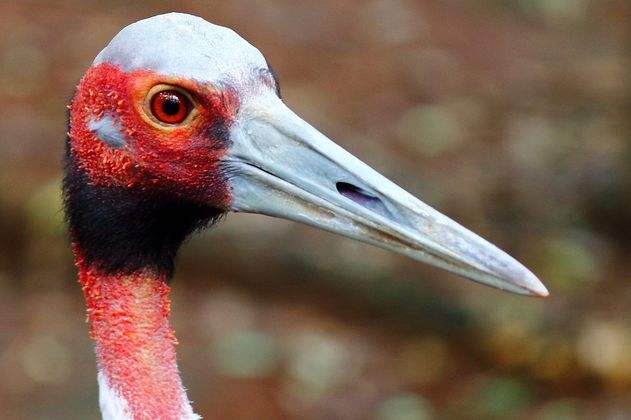
Grus antigone
Grus antigone,Sarus Crane
Features:The head, throat and upper neck are bare and featherless, with rough, grainy skin and bright red in color.
Sarus Crane is a large wading bird with three subspecies.Sarus Crane often moves alone or in pairs or family groups. In autumn and winter, it sometimes gathers in large groups of dozens or even hundreds of individuals. It is timid and alert. They mainly feed on fish, frogs, shrimps, lizards, grains...
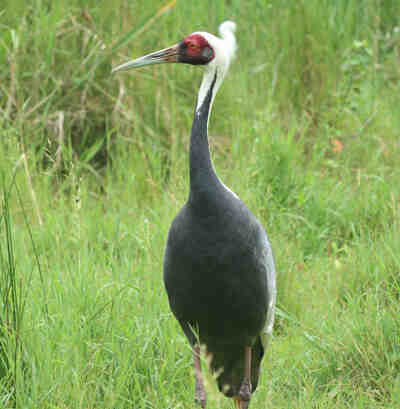
Grus vipio
Grus vipio,White-naped Crane, red-faced crane, white-crowned crane, native crane
Features:On the Korean Peninsula, the white-naped crane is seen as a symbol of peace.
White-naped Crane is a large wading bird with no subspecies.White-naped Crane mainly feeds on plant seeds, grass roots, young leaves, young shoots, grains, fish, frogs, lizards, tadpoles, shrimps, mollusks and insects. When feeding, they mainly use their beaks to peck, or use their beaks to first op...

Grus leucogeranus
Grus leucogeranus,Siberian Crane ,Siberian White Crane, Snow Crane,Siberian Crane, Nun Crane, Snow Crane
Features:It symbolizes good luck and longevity in Chinese culture and is the provincial bird of Jiangxi Province.
The Siberian Crane is a large wading bird. Although it is divided into three populations, namely the eastern, central and western populations, it is a monotypic species with no subspecies differentiation. Known as the "living fossil" of birds, there are less than 4,000 of them in the world...

Tetrax tetrax
Tetrax tetrax, Little Bustard,Outarde canepetière, Sisón,Ground
Features:The neck has a white horizontal band and a "V" shaped diagonal band
Little Bustard, also known as Little Bustard in English, is a large bird of the family Bustard, with no subspecies.Little Bustards often gather in large groups during the non-breeding season, sometimes up to several thousand, and are active during the day. Male birds in the wintering group have coll...
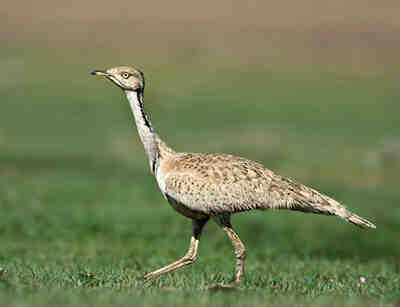
Chlamydotis macqueeni
Spotted Bustard、Chlamydotis macqueeni,Macqueen's Bustard
Features:The bustard is smaller than the larger one, and looks like a chicken, but has only three toes.
Houbara Bustard, also known as Macqueen's Bustard, has no subspecies. A large ground-dwelling bird, once a subspecies of the Ruffed-jawed Bustard, it has been reclassified as an independent species.Like other bustards, the Houbara Bustard is a bird of open and desert areas. In Xinjiang, it mainl...
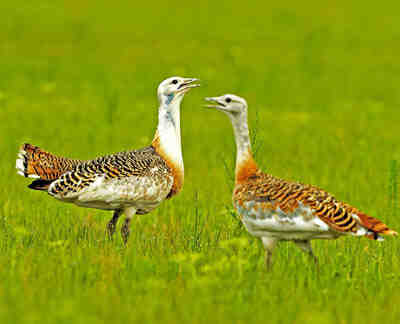
Otis tarda
Otis tarda,Great Bustard,Avutarda, Avutarda Común,Додук, Մեծ արոս, Дуадақ,Ground quail, old brocade, lone leopard, wild goose
Features:It is one of the two largest species of bustard birds (the other is the Grey-necked Bustard).
The Great Bustard has two subspecies, both of which are distributed in China. The common subspecies breeds in Qiqihar, Heilongjiang, Tongyu and Zhenlai, Jilin, northwest Liaoning, and Inner Mongolia. It hibernates in Liaoning, Hebei, Shanxi, Henan, Shandong, Shaanxi, Jiangxi, Hubei and other provinc...
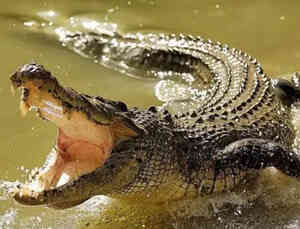
Alligator sinensis
Alligator sinensis ,Chinese Alligator,Alligator, Chinese alligator, earth dragon, pig dragon
Features:It is endemic to China, has a flat head, short and thick limbs, a long and laterally flattened tail, scales with more granular and banded patterns, and earth-colored eyes.
The Yangtze alligator, Alligator sinensis (Fauvel, 1879), was called tuó in ancient times, and is commonly known as "earth dragon" or "pig dragon" in the folk. It is a small crocodile unique to China and is listed as a national first-class key protected wild animal. The Yangtze...
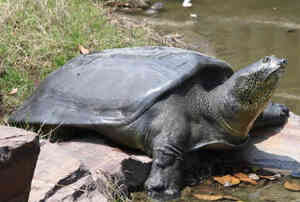
Rafetus swinhoei
Rafetus swinhoei,Yangtze Giant Softshell Turtle;Swinhoe's softshell,Rùa Hồ Gươm,Taihu turtle, giant softshell turtle, spotted softshell turtle, and Stuart softshell turtle
Features:The head, neck and back of the limbs are also dark green with irregular yellow spots of different sizes. This dense yellow pattern is a characteristic of the Yangtze giant softshell turtle.
In ancient times, the Yangtze giant softshell turtle was widely distributed in the lower reaches of the Yangtze River and the Taihu Lake area in China. The ancients called it the 癞头缋. Due to wanton hunting and ecological damage, no wild individuals have been found since 1972. There are only two c...
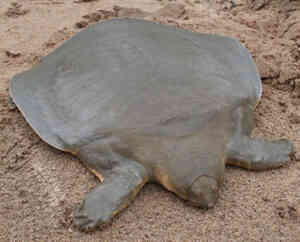
Pelochelys cantorii
Pelochelys cantorii,Frog-faced Softshell Turtle、Asian Giant Soft-shelled Turtle、Cantor's Giant Softshell,Blue grouper, silver fish, green grouper, giant turtle, spotted turtle, Cantor's gian
Features:The largest species of turtle, it has a relatively small head and small eyes. It likes to live in groups and has a long lifespan.
Before and after the release of the "List of National Key Protected Wildlife in China" in 1989, according to the "Fauna Sinica", all giant freshwater turtles in China were called "turtles". Therefore, the turtle (then scientific name Pelochelys bibroni), which was liste...
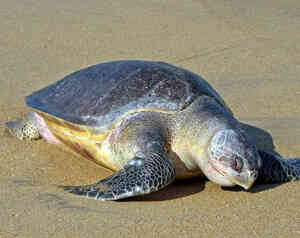
Lepidochelys olivacea
Lepidochelys olivacea,Olive Ridley, Pacific Ridley,Ridley du Pacifique, Tortue Bâtarde, Tortue Olivâtre, Tartaruga-comum, Tartaruga-oliva, Tartaruga-pequena,Tortue de Ridley,Tortuga Carpintera, Tortug
Features:The limbs are flat like paddles. The head, limbs and back of the body are dark olive green, and the plastron is light orange-yellow.
The Olive Ridley is marine and little is known about its behavior other than its regular annual trips to nesting beaches. It feeds in the morning and basks on the surface in the afternoon. Large groups of turtles gather together to bask in the afternoon to escape the freezing temperatures of the wat...
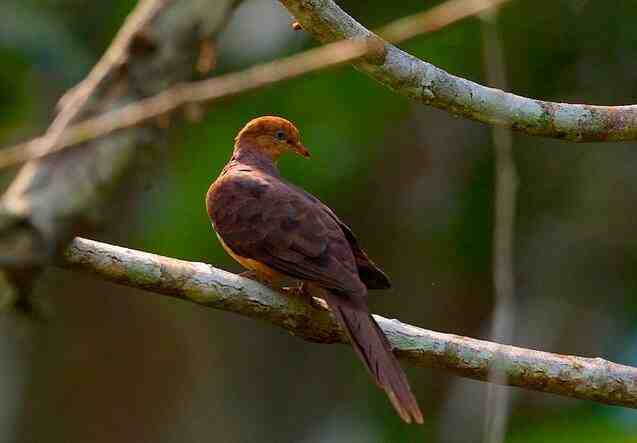
Macropygia ruficeps
Brown-headed cuckoo dove, Lesser red cuckoo dove,Macropygia ruficeps,Little Cuckoo-dove
Features:Has a brown head
Little Cuckoo-dove is called Little Cuckoo-dove in English, and there are 8 subspecies.Little Cuckoo-dove is a resident bird, usually moving in groups. It moves calmly, and always stays for a while before taking off when it encounters danger. It has a low voice. It mainly feeds on plant fruits, seed...

Testudo horsfieldii
Testudo horsfieldii,Afghan Tortoise Central Asian Tortoise Four-toed Tortoise Horsfield's Tortoise Steppe Tortoise,Land turtle, taspaha, prairie tortoise, land tortoise, turtle
Features:The four-clawed tortoise is the only tortoise that lives in the desert grasslands of my country.
In the Yili River Valley in Xinjiang, China, there is a small creature called "Tasipaka". "Tasipaka" means "stone" and "Paka" means "toad". What kind of animal is this stone-like toad? It is the four-clawed tortoise, which is listed as "critical...
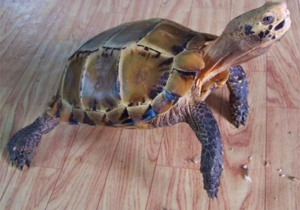
Manouria impressa
Manouria impressa,Impressed Tortoise, Kirin tortoise
Features:As the name suggests, the carapace is flat and even concave in the middle, forming a groove with three horizontal lines.
Concave-shelled tortoise lives in tropical and subtropical mountainous areas. Adults live on the banks of mountain streams, and young turtles can climb up to the banks and lie horizontally on tree trunks to bask in the sun. They live far away from water and have a narrow distribution area. They feed...
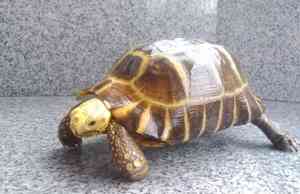
Indotestudo elongata
Indotestudo elongata,Elongated Tortoise,Yellow elephant turtle, pillow turtle, dry turtle, Burma land, dragon claw turtle and so on
Features:Big eyes, short neck, high back and long nails.
Burmese tortoises are subtropical terrestrial tortoises, living in mountains, hills and bush forests, active at night, warm and afraid of cold. Docile, spiritual, mainly herbivorous, but also eat animal food, can feed melons, fruits, vegetables, lean meat, etc., like to eat tomatoes. The optimum te...
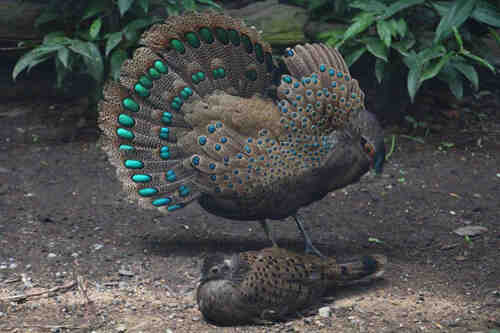
Polyplectron katsumatae
Polyplectron katsumatae,Hainan Peacock-pheasant
Features:It is one of the rare and endangered pheasant species, and the male adult bird resembles the gray peacock named subspecies, but is much smaller
Hainan Peacock pheasant has no subspecies.Hainanese pheasants often move alone or in pairs, and will flee if disturbed. It rarely rises to the top of the tree and burrows into the dense branches. They perch on branches at night. Travel alone or in pairs, forage on the ground and spend the night in t...
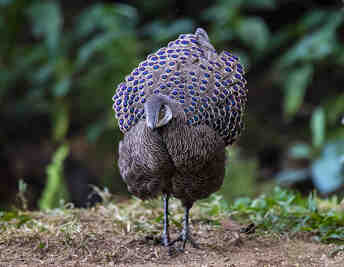
Polyplectron bicalcaratum
Peacock chicken, money chicken,Polyplectron bicalcaratum,Grey Peacock-Pheasant
Features:The upper back, wings and end of the tail feathers are named for their gorgeous eye spots like a peacock
Polyplectron katsumatae (Polyplectron katsumatae) was developed in 2004 by the Hainan Provincial Forestry Bureau, Hainan Normal University and Beijing Normal University. Through DNA sequencing and molecular genetic markers, it was found that the genetic distance between Hainanese peacock pheasant an...
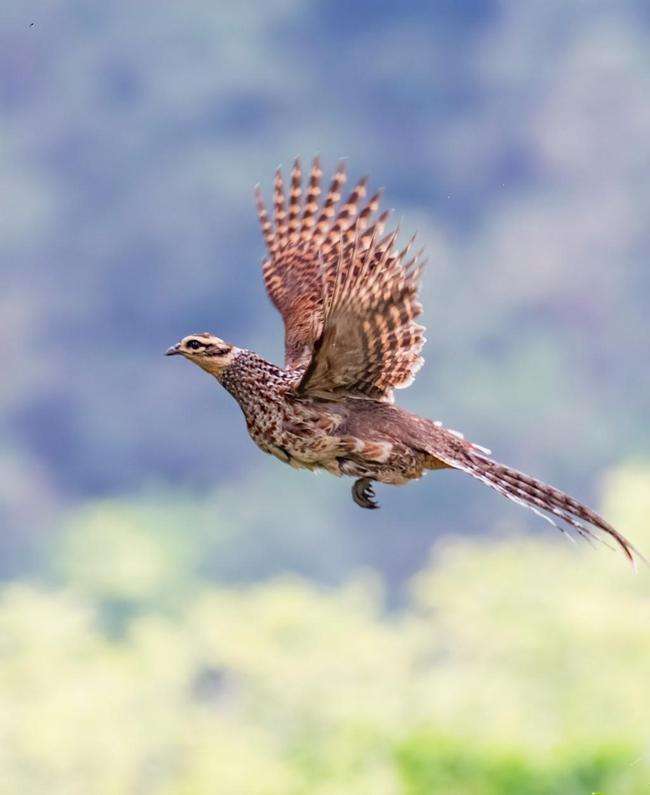
Syrmaticus reevesii
Zhai bird, ground chicken, long-tailed chicken, mountain pheasant,Syrmaticus reevesii,Reeves's Pheasant
Features:Bird with the longest tail feathers
The white-crowned long-tailed pheasant is also known as Reeves's Pheasant. It has no subspecies and is a beneficial bird in the forest.The white-crowned long-tailed pheasant mainly feeds on plant fruits, seeds, young shoots, tender leaves, flowers, tubers, roots, and seedlings and grains of crop...
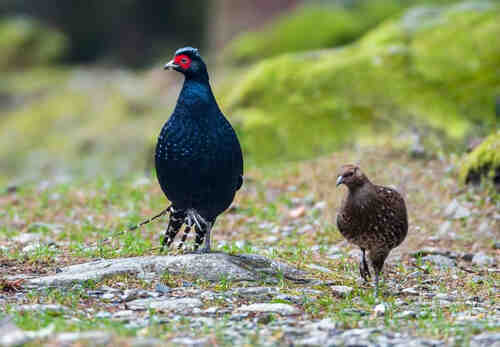
Syrmaticus mikado
Imperial Pheasant,Syrmaticus mikado,Mikado Pheasant
Features:The guardian of love, the bird that lives at the highest altitude among all pheasants in Taiwan, China
The black long-tailed pheasant is called Mikado Pheasant in English. It has no subspecies and is a large chicken.The black-tailed pheasant is active in places where the surface plants and fallen leaves on the forest road are covered, and it also walks on steep cliffs. It is mostly active alone and d...
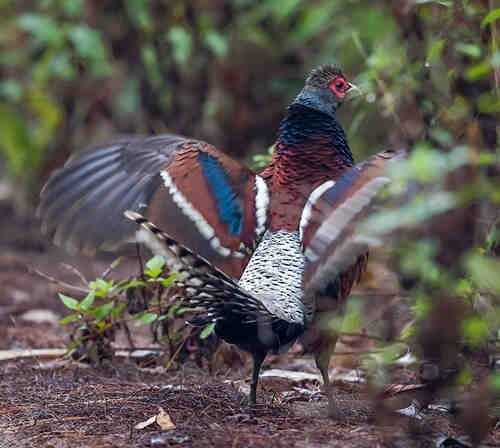
Syrmaticus humiae
Ground Chicken,Syrmaticus humiae,Mrs. Hume’s Pheasant
Features:Because they rarely chirp, they are also called dumb chickens.
Mrs. Hume’s Pheasant, also known as Mrs. Hume’s Pheasant, has two subspecies.Mrs. Hume’s Pheasant is a resident bird. It often wanders in pairs or small groups to forage. Usually they come down from the trees after daybreak and stay active until dusk. They rest in the open space or bushes in the...
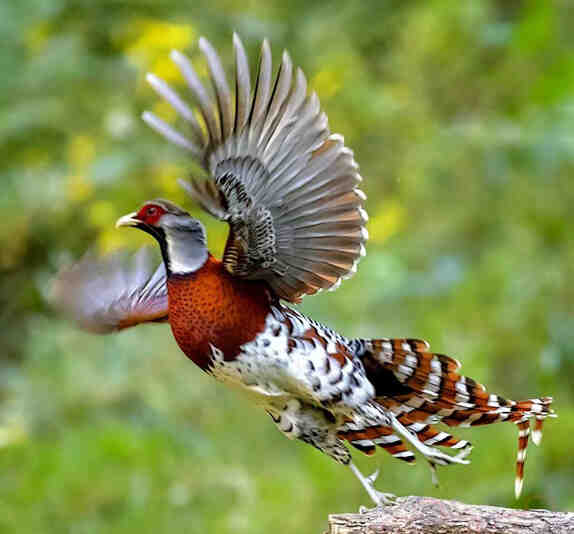
Syrmaticus ellioti
Striped back chicken,Syrmaticus ellioti,Elliot's Pheasant,Chinese Barred-backed Pheasant
Features:It is a typical species of the eastern hilly plain subregion of the Central China region of the Oriental Realm.
Elliot's Pheasant, also known as the White-necked Pheasant, has no subspecies and is a large chicken.Elliot's Pheasant is a resident bird. It likes to gather in groups, often in small groups of 3-8. They often move in and out of rugged mountains and valleys with dense forests and complex ter...
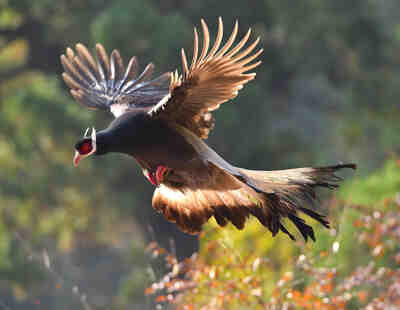
Crossoptilon mantchuricum
Crossoptilon mantchuricum,Horned chicken, pheasant, Yi bird
Features:It is the most precious species of pheasant, known as "鹖" in ancient times.
Brown Eared-pheasant, with no subspecies, is a bird that inhabits mountain forests.Brown Eared-pheasant is the most precious species of pheasant, and was called "鹖" in ancient times. "鹖" is recorded in "Qin Jing" as "鹖", a strong bird. "Yi does not kno...
